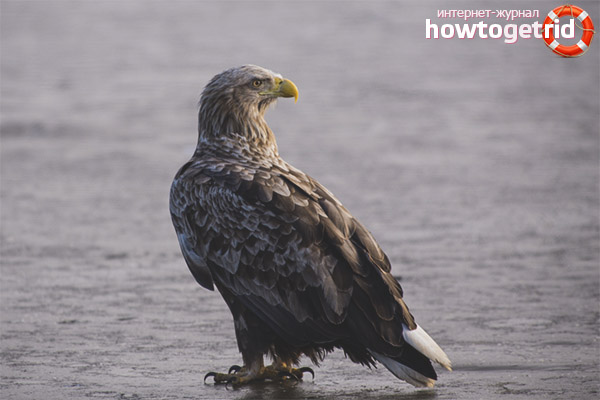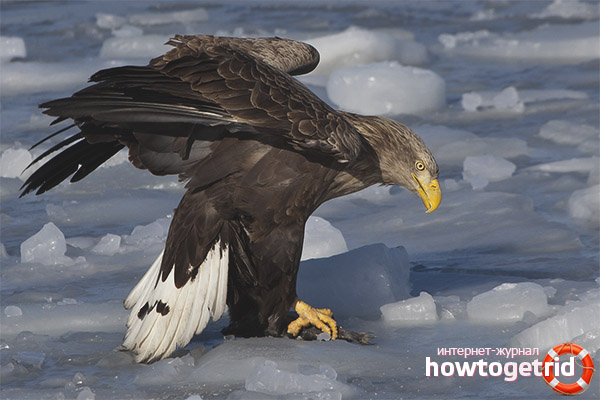The content of the article
When it comes to birds belonging to the category of predators, the eagle involuntarily recalls. Proud, beautiful, powerful, he attracts attention. Usually hovering over flattering terrain, spacious fields and tall trees. It is found over the water surface of lakes and raging seas. It amazes not only with beauty, but also with greatness. Today we will consider everything that affects the presented family. We will study what individuals eat, where they live, and how their mating season goes. Let's not get ahead of ourselves, consider the subtleties in order of priority.
Habitat
- Birds of prey category are quite widespread, they live in almost all parts of the globe. The only exception is the region of South America and Antarctica. Four species of eagles are available in the vastness of our country.
- The most popular is the white-tailed eagle. As the name implies, the external data of the bird suggests the presence of a white tail. The bird prefers brackish or fresh water sources with plenty of sunlight.
- There is another species of individuals of this family - Steller's sea eagle. His areas in the upper parts of the wings are whitish. There are representatives on the shores of the Pacific Ocean. It is worth considering the bald eagle, which is a symbol of the United States of America. It is this bird that is depicted on state signs.
- There is also an eagle screamer, common in African countries. It is considered a national symbol of the local places. Birds from a predatory family prefer to feast on fish, if there is such an opportunity. They get food in ponds, in open spaces and rivers.
- Birds prefer to live near deep and vast water places. They are attracted by the seashores, estuaries, rivers, lakes. Individuals do not fly into the open spaces, similar to the wilderness. The presented species does not migrate every year. However, in cases where water sources with food are covered with ice, the habitual expanses leave the habitually.
- When a couple develops during the mating season, it occupies its territory and lives on it for many years. Two birds occupy more than 10 hectares of water. On the same site along the coast, nests are later built, chicks are raised and trained. When it comes time to rest, the eagles move into the deciduous forest.
Description
- These birds are categorized as buzzards. If you translate the name from the Greek language, it means "sea eagle." The bird, according to its overall characteristics, is quite large; in terms of wingspan, the indicators reach 250 cm or more. As for the mass of the case, it varies between 3.5-7 kg. The growth of birds is 80-100 cm.
- If we compare the inhabitants of the southern and northern latitudes, the former are much smaller in size. Eagles have large and wide wings, the same can be said about the tail. Legs are strong, with long clawed toes. It is the claws that help grab the fish and hold it.
- The yellowish beak bends down with a hook, it is massive and strong. There are eyebrows in the eye area that give the bird a frown. The irises are brownish with a yellow tint, which is characteristic of all eagles.
- On plumage, individuals are brownish, there are white inserts. Each individual is unique in its own way. The head can be whitish, as well as the shoulders, tail and body. The main color is brownish or similar in color. As for the differences in gender, they are practically absent. Females may be slightly larger.
Lifestyle
- Birds are awake, preferably in the daytime.They hunt when it’s light, get food and do their own thing in every possible way. When an individual flies, it can soar or dive.
- When a bird flies around the territory, it soars for the most part. Looks for prey, can slow down, and then fly down at full speed. The wings are wide and strong, allowing for a long time to spend in the sky.
- If the eagle notices prey, it approaches it at a speed of up to 100 km / h. An individual falls from a height, grabs future food with strong claws and carries it to the sky.
- In cases where the own territory is too large, the bird chooses a convenient site as a place for observation. From it, an individual monitors the surroundings.
Food
- The main food sources of these birds are considered water open spaces. That is, they feed on waterfowl, large fish, which in weight can reach 3 kg. We are talking about trout, pike, sockeye salmon, mullet, herring, pink salmon, etc. Such a choice is determined not only by the appetite of these individuals, but also by the excitement of hunting.
- Since birds of prey, they choose weakened or small individuals. They hunt ducks, gulls, and coots. They drive the game until it gets tired. Then grabbed, dragged ashore and killed. A bloodthirsty and not everyone's sight.
- The daily diet includes small mammals. They hunt the middle ones less often. They eat raccoons, hares, rats, squirrels. They feed on crustaceans, frogs, turtles.
- The considered individuals are also not averse to profit from carrion. Birds do not show any squeamishness to fish washed ashore, whales and corpses of various animals. In addition, the eagles are quite large in size, so they often take food from smaller predators. Also, individuals often steal prey from their relatives.
- Often, the considered individuals prefer to hunt in shallow water. In such places, a huge amount of fish accumulates, and getting it is quite simple. As soon as the eagle notices potential prey, it rushes with a stone down from a height behind it. At the same time, the wings of the predator do not get wet at all.
- Often, eagles just walk in shallow water and peck out fry, various animals. In other cases, the considered individuals are capable of dragging a victim weighing up to 3 kg. If the eagle has caught a larger prey in the water, he will pull it ashore and calmly feast on it.
- Often you can observe such a picture that a pair of eagles preys on large prey. They do this together, as the beast can be very fast. In addition, individuals attack large birds. At this time, one eagle begins to distract predators, the other suddenly attacks. Eagles intercept small birds right on the fly.
- When the presented predators prey on waterfowl, eagles make them dive. At this time, they circle over the victim. As soon as the prey begins to lose strength, the eagle immediately catches it and pulls it ashore. When the predator starts the meal, he presses the victim with one paw to the ground.
- The eagle begins to tear the flesh even on live prey. Often such predators try to retire during a meal. They do not like to share with relatives. Often the hungry get together trying to take away food. If the eagle has blocked up large prey, he will have enough of such food for a long time. In addition, such individuals are able to gain up to 1 kg in their goiter. food.
The considered individuals belong to monogamous pairs. In an extreme case, when the satellite dies, the eagle finds a replacement. Pair formation occurs at a young age. The construction of the steam nest proceeds together. The male finds building materials, and the female at this time builds a nest.
Video: White-tailed Eagle (Haliaeetus albicilla)











Submit